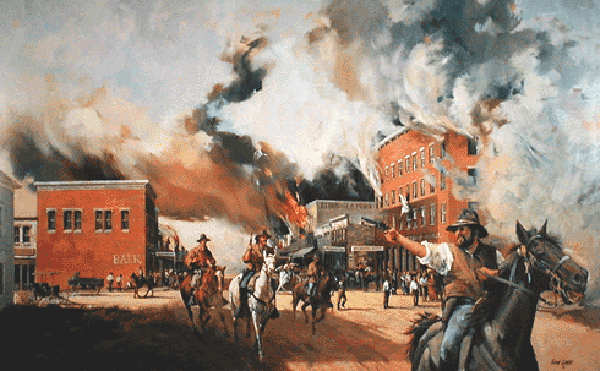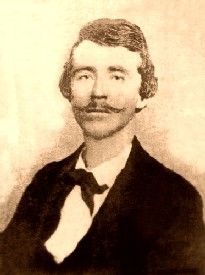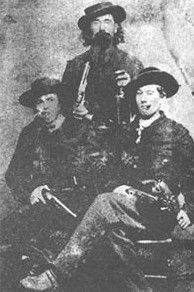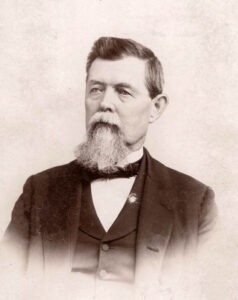
Quantrill Raid, painting by Ernst Ulmer.
On the evening of September 6, 1862, William Quantrill led his Confederate guerrillas, numbering from 125 to 150, in a raid against Olathe, Kansas.
Quantrill was the leader of the most savage fighting band during the Bleeding Kansas era and into the Civil War.
Finely mounted and thoroughly armed, the group of men proceeded up Coffee Creek. When they came to the home of David Williams, six miles east of Olathe, they found Frank Cook, who had just enlisted in the company then being formed at Olathe for the Twelfth Kansas. They took him prisoner and rode away. The next day Cook’s body was found in a ravine some distance from the Williams home, with two bullet holes in his chest and his head horribly mangled by a musket ball.
A mile and a half east of Olathe, the invaders found brothers John J. Judy and James B. Judy, who had enlisted in the same company with Cook. They made them prisoners, took all the valuables they could find, and left. The next day the two brothers were found, their bodies riddled with bullets, in a ravine on the farm owned by Jonathan Millikan, about halfway between the Judy home and Olathe. It was almost midnight when Quantrill and his men reached Olathe and moonlight was almost bright enough to read by. Entering Olathe, Quantrill halted his men and gave them instructions. A party of citizens had just returned from De Soto and entered a saloon that stood on the east side of the public square. Jiles Milhoan, a police judge of Olathe, had left a $400-team of horses and wagon in front and, looking out a rear window, saw the cavalcade coming up the hill from Mill Creek’s crossing. The citizens were expecting a company of Union cavalry, and going outside, one of the crowd, William Roy, the post adjutant, hailed them with the inquiry, “Is that Captain Harvey’s company?” Someone answered: “Yes,” and the men turned back towards the saloon. At that time, the Santa Fe Trail crossed on the east side of the public square. Quantrill then commanded, “File right, file left. Take immediate possession of the town, and don’t let a man escape!”
Jiles Milhoan heard the command and said: “Boys, them’s bushwhackers,” and made for his horses intending to cut them loose from the wagon and let them run, but he was too late, a bushwhacker, reinforced with a gun, ordered him to “let that team alone and fall in line,” which he did. About that time, Hiram Blanchard, a young merchant who had come up from Spring Hill, ten miles south of Olathe, that night in company with Judge Ezra Robinson, of Paola came out of a saloon and walked across the street to where his horse was tied to the fence around the square. Blanchard then went to the other side of the horse, untied it, and putting his foot into the stirrup was in the act of mounting when the bushwhackers shot him through the head.
Judge Robinson also had a narrow escape that night. He knew Quantrill personally, and Quantrill promised Robinson to get his horse back for him if he could and cautioned him to keep close to him, to be safe. Shortly afterward, Robinson went to the home of Cliff Turpin, who was one of Quantrill’s men. In the parlor, he found a troop of bushwhackers and heard Mrs. Turpin welcoming them with, “I’m glad to see you, boys. If you had come two weeks ago, when I sent you word, I would have had something for you to eat.” Just then, Cliff Turpin entered and took in the situation. Robinson had heard too much for the health of the Turpin family, and it was promptly decided to kill Robinson. However, Mrs. Turpin protested against them killing anyone in her house, and the gang started out of the house, pushing Robinson along. Reaching the front door, they met another troop of Quantrill men coming in, giving Robinson a chance, and he took it. Bolting through the door, he turned south and ran to where a few women were huddled together and hid behind them. When his pursuers came up, one of the women had the presence of mind to say that Robinson had just disappeared around an adjacent building and directed them in that direction. At that, Robinson lost no time “making his get-away.”
In the meantime, the guerillas had spread over the town, entering every house and bringing all the men into the public square. Several recruits were sleeping upstairs in a building, and as the guerillas rushed upstairs, a young recruit named Phillips Wiggins caught one of them by the throat, took his pistol away, and proceeded to choke him when he was shot through the head and instantly killed. Another recruit named Josiah Skinner was sleeping on the floor of a building that stood on Park Street. He was sound asleep, and several shakings failed to wake him. A bushwhacker shot him through the body, saying: “Lay there if you won’t get up.” Skinner died a few days afterward.
During the night, another citizen, Marian Milhoan, was shot in the foot while trying to get away.
Colonel J. E. Hayes, who had recently been appointed Colonel of the Twelfth Kansas, narrowly missed being caught in the raid. He was in Leavenworth that day, where John Taylor Burris, who was Colonel of Tenth Kansas, was in command. Intending to return home that afternoon, he started for Olathe, but it having rained, he turned back to get his horse shod and missed being at home. However, Mrs. Hayes was at home, lodged at the American House, and received a visit from the marauders. In a closet in her room were stored several soldiers’ uniforms. Placing herself in front of the closet door, she managed to hide it while the men searched her trunk standing close by and saved the uniforms. The Colonel’s sword she saved by throwing it into the backyard.
The two newspaper offices, the Olathe Herald and The Mirror were wrecked. All the arms for the new company were loaded in Milhoan’s wagon. Everything of value in the town, including money, jewelry, and even bed clothing, groceries, and dry goods, was loaded into wagons and brought into the square. Finally, the citizens were released, but the recruits were kept as prisoners.
After Jiles Milhoan was released, he met Cliff Turpin, whom he knew, and asked him to intercede with Quantrill to give him back his team. They found Quantrill sitting on the porch of Judge Campbell’s house. Quantrill said the arms had been loaded into that wagon, but if Milhoan wanted to go along, he would return the team when they reached the point where they intended to unload. However, he advised him not to take the chance, as some of the men would undoubtedly kill him and take the team before he got a mile away, and he could not send a guard back with him. Milhoan took Quantrill’s advice. After the inhabitants were gathered into the square, they were held up for any money they had.
About daylight the recruits were ordered to “fall in,” and the wagons loaded with plunder, started south towards Spring Hill. Quantrill and his men followed on horseback, with the prisoners on foot. Cliff Turpin offered William Pellett a big horse with a sore back to ride on the march south. Pellett accepted it. As they proceeded, an old bushwhacker rode alongside Pellett and urged him to jump and run as he could easily escape that way, saying: “You d__n little Yankee school-master, run, you can get away just as well as not.” Mr. Pellett replied that he was a good runner all right but added, “I’m afraid I couldn’t outrun that shotgun of yours,” and declined to run. The news that several companies of soldiers had arrived at Spring Hill diverted Quantrill eastward through the fields of Squiresville where Quantrill lined up the recruits and informed them that he had been deliberating whether or not to shoot them, but had decided to turn them loose, which he did after taking their paroles. They reached Olathe about noon, footsore, weary and hungry.
The next day, Colonel Burris started in pursuit with several cavalry troops and succeeded in recovering the arms and most of the goods taken from the stores. So ended Quantrill’s first raid, but Olathe was a sorry wreck; scarcely a door or window in the town remained unbroken, and it took quite a while for its people to recover from the blows. Afterward, Olathe suffered but little during the remaining years of the war.
Source: Blair, Ed; History of Johnson County, Standard Publishing Company, Lawrence, KS, 1915. Compiled and edited by Kathy Alexander/Legends of America, March 2022.
Also See:
Olathe, Kansas
William Quantrill – Renegade Leader of the Missouri Border War



